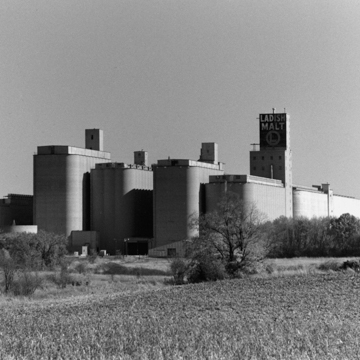Grain elevators like these exerted a formative influence on the International Style. The sinuous lines and smooth concrete walls of the massive cylindrical elevators matched form to function, and the structures emphasized what Le Corbusier, in Toward a New Architecture (1931, English translation), called “the magnificent play of masses brought together in light.” Grain elevators, he wrote, were “the magnificent first-fruits of the new age.” When grain merchants James Lytle and Joseph and Charles Stoppenbach formed the Lytle-Stoppenbach Company (predecessor to the Ladish Malt Company) in 1898, they built functional structures for malting barley, the first step in brewing beer. Maltsters steep barley in vats of hot water, allow it to germinate, kiln-dry the resulting malt, and then ship it to the brewer, who cooks the malt in water to make wort, the liquid beginnings of fermented beer. Although brewers did their own malting in the early years of Wisconsin’s brewing industry, a brewing boom in the 1860s and 1870s fostered a separate malting industry.
While most of the surviving structures in this massive complex took shape after 1936, development began in 1898 when the first grain elevators stood next to the Chicago and North Western Railway tracks. Within fifteen years, the company produced one million bushels of malt per year. Most of the complex was constructed of fireproof materials after 1904, but in 1936, an electrical fire destroyed one of the structures. The company used the insurance money for a major expansion, adding steeping and germinating rooms, malt kilns, and concrete barley tanks, many 120 feet tall, linked by a continuous concrete skin and tall elevators. The four enormous barley tanks—oblong-shaped with rounded corners and flat roofs—dominate the landscape. Their fluted walls are punctuated by stepped, skyscraper-like elevators at irregular intervals. The repetitive, undulating curves in the wall, reflecting the individual silos, give the complex the sort of visually striking character that inspired European modernists.


